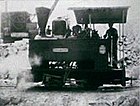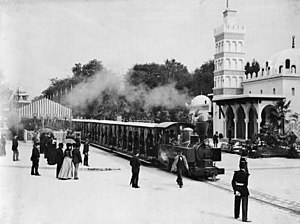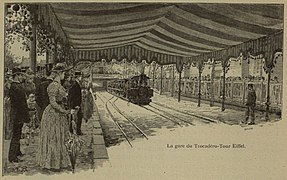Decauville Railway of the Paris World's Fair (1889)
| Decauville Railway of the Paris World's Fair (1889) | |||||||||||||||||||||||||||||||||||||
|---|---|---|---|---|---|---|---|---|---|---|---|---|---|---|---|---|---|---|---|---|---|---|---|---|---|---|---|---|---|---|---|---|---|---|---|---|---|
|
Train in front of the Pavillon de l'Algérie
| |||||||||||||||||||||||||||||||||||||
|
Route
| |||||||||||||||||||||||||||||||||||||
| Route length: | 3 km | ||||||||||||||||||||||||||||||||||||
| Gauge : | 600 mm ( narrow gauge ) | ||||||||||||||||||||||||||||||||||||
| Maximum slope : | 25 ‰ | ||||||||||||||||||||||||||||||||||||
| Minimum radius : | 45 m | ||||||||||||||||||||||||||||||||||||
| Top speed: | 10 km / h | ||||||||||||||||||||||||||||||||||||
| Dual track : | At a distance of 2 m | ||||||||||||||||||||||||||||||||||||
|
|||||||||||||||||||||||||||||||||||||
The Decauville train the Paris World Exhibition in 1889 ( French Chemin de fer intérieur de l'Exposition universelle de 1889 ) was a three-kilometer long Decauville - narrow-gauge railway with a track width mm 600, during the World Expo Paris 31 from 6 May to October In 1889 drove from Esplanade des Invalides to Avenue de Suffren .
Route
At 90 hectares, the area of the World Exhibition of 1889 was too large to be explored solely on foot. Therefore, an internal railway was built connecting the exhibition buildings on the Esplanade des Invalides with those under the Eiffel Tower . The three-kilometer-long railway line began 250 meters from the Concorde Bridge at the Ministry of Foreign Affairs near the Seine . She crossed the Esplanade des Invalides and followed the Quai d'Orsay on the banks of the Seine within the fence of the World's Fair between the two rows of trees furthest from the bank. It crossed the Boulevard de La Tour-Maubourg at a level crossing, ran in a 106 m tunnel under the avenues Rapp and avenue Bosquet , crossed the avenue de la Bourdonnais , then drove in an underpass past the Eiffel Tower and finally turned in a 90 ° -Turned onto Avenue de Suffren , which she followed to the terminus at the Galerie des Machines .
In addition to the two terminus, there were three stops on the Quai d'Orsay: the first at the Malar intersection, the second opposite the Palais des Produits Alimentaires, the third on the corner of Quai d'Orsay and Avenue de Suffren. The infrastructure and rail vehicles were supplied by Decauville . The line was double-tracked with a distance of two meters.
The station buildings at the stops were sights that could be seen from afar and attracted passengers. The son of one of the concessionaires, Louis Gaillot, a young architect, gave them forms of unusual originality and functionality. The awnings that covered the platforms offered passengers protection from the elements. At the terminal stations there were buffets where the passengers could meet and relax.
construction
The track was designed by the general director of works, Monsieur Alphand, who commissioned Antoine Gaillot and Paul Gallotti of Gaillot et Cie to build the track under the supervision of Monsieur Lion, the exhibition's engineer. The construction work was led by the deputy chief engineer and responsible for the metalwork J. Charton, who dealt in particular with the construction of the railway on the Champ de Mars .
business
There were regulations that regulated the operation of this railway line by the concessionaire. The trains had to leave the terminus every ten minutes from 9 a.m. to midnight, i.e. six trains per hour or 90 trains per day in each direction. On Sundays, up to 150 trains could run in each direction. Although the route was completely closed to public traffic for most of its length, a low maximum speed of 10 kilometers per hour was set. This maximum speed should even be reduced to four kilometers per hour at certain points along the route, especially at level crossings where a train attendant preceded each train . The length of the trains was not allowed to exceed 50 meters and they were all equipped with a fast-acting brake.
The fare was a uniform 25 centimes per person in an open summer car and 50 centimes in a saloon car, regardless of the length of the journey. Passengers could buy their tickets in advance at many sales points. It was enough to show the tickets to the railway staff to get into the car. At the exit they were deposited at the turnstiles. According to the official census, 6,342,446 passengers were carried during the six-month operating time.
To be on the safe side, there was a remote-controlled, disc-shaped signal at each stop that could only be released when the barrier was closed. All trains were announced by a system of electric bells that led from the level crossings to the nearest station. After all, there was a telephone service in every station.
operating cost
After the first month of operation it was found that the total cost of running the railroad was £ 120 per day, of which £ 40 was for wages, fuel, oil and storage, £ 40 for track and rolling stock depreciation and interest on capital, and £ 40 Set aside to cover the later costs of backfilling the tunnels and cuttings and restoring the road surface. In addition, the French administration imposed a tax per thousand passengers carried.
On a few days, almost 40,000 people drove into the exhibition, and the train carried its millionth passenger within six weeks. She had gross income of £ 10,000, or about £ 240 a day, during that period. On this basis, it was confidently projected that the railway's gross revenues would exceed £ 70,000 over the six months of the show as it was not believed that traffic would decrease.
Locomotives
Only steam locomotives of various types were used. One was from the artillery captain PECHOT these Fairlie - double locomotive was specifically designed for the use of the army. In addition, locomotives based on the mallet principle, patented in 1884, were used. The wagons that were used for passenger transport were of different types that were similar to those of the Army Ministry.
There were around 12 steam locomotives and 100 wagons of various types in operation. The Swede Fredrik Arvidsson Posse bought two of the locomotives shown in Paris, Massouah and Turkestan , two passenger cars and track material and used them on the Helsingborg – Råå – Ramlösa Järnväg , which was inaugurated on July 16, 1891 . Other of the locomotives on display were later used on the Tramways de Royan , the Chemins de fer du Calvados and the Decauville Railway near Diego Suarez :
| Wheel alignment | Weight | Serial number | Dealer number | Surname | image | Remarks |
|---|---|---|---|---|---|---|
| 0-4-0T | 3 t | Couillet 903/1887 | Decauville 56/1887 |
Ma Camarade Later: Marc Seguin |
 |
Sold to De Malzine, Carrières de Rogeries, Département Nord . |
| 0-4-0T | 3 t | Decauville 49 | La Mignonne |  |
Sold to Decauville Railway Diego Suarez - Camp d'Ambre . | |
|
0-4-4-0T PECHOT |
9.5 t | Pechot 1 | Decauville 57 | France |  |
12 t operating weight, sold to Direction d'Artillerie de Toul (No. 1). |
| 0-4-4-0T Mallet |
9.5 t | Tubize 661/1887 | Decauville 52 |
L'Avenir later Sergent Bobillot |
 |
12 t operating weight, suitable for 8% inclines, radii of 20 m and rails with 9.5 kg / m. |
| 0-4-4-0T Mallet |
9.5 t | Tubize 697/1887 | Decauville 58 | Later Kosta |  |
Sold by Canon Legrand in Mons and Raismes to Hummel in Sweden. |
| 0-4-4-0T Mallet |
9.5 t | Tubize 713/1888 | Decauville 59/1889 |
Ville de Laon later Diego Ferre |
 |
Sold in 1891 to Tramways de Royan , later in 1896 to the sugar plantation in Pardu ( Peru ) through Decauville's Ayulo & Cie . |
| 0-4-4-0T Mallet |
9.5 t | Tubize 735/1889 | Decauville 71/1889 |
Massouah Later Råå |
Then the Helsingborg – Råå – Ramlösa railway line | |
| 0-4-4-0T Mallet |
9.5 t | Tubize 736/1889 | Decauville 72/1889 |
Kairouan later Varaville |
Sold in 1891 to Tramways de Royan, later to Chemins de fer du Calvados (N ° 6). | |
| 0-4-4-0T Mallet |
9.5 t | Tubize 739/1889 | Decauville 73/1889 |
Turkestan Later Helsingborg |
 |
Then the Ormaryd – Anneberg railway line . Until 1907 the Helsingborg – Råå – Ramlösa HRRJ N ° 2 railway line , scrapped in 1923 |
| 0-4-4-0T Mallet |
9.5 t | Tubize 751/1889 | Decauville 74/1889 |
Australie Later Cabourg |
1891 sold to Tramways de Royan, later to Chemins de fer du Calvados (N ° 1). | |
| 0-4-4-0T Mallet |
9.5 t | Tubize 752/1889 | Decauville 75/1889 |
Dumbarton Later Madagascar Later Sallenelles |
 |
Sold in 1892 to Chemins de Fer du Calvados (N ° 2, Sallenelles ), 1908 to Bourillon & Pelleron. |
| 0-4-4-0T Mallet |
9.5 t | Tubize | Decauville 80/1889 | Hanoi later Haiphong | Later the Hanoi – Đồng Đăng railway line |
Individual evidence
- ↑ a b c Trajet du chemin de fer-tramway Decauville.
- ↑ Plan général de l'Exposition Universelle de 1889.
- ^ A b c d e f g h i F. Frédéric Moreau, Ingénieur civil des Mines: Chemin de Fer-Tramway Decauville de l'exposition Paris 1889. 1889.
- ↑ a b L'exposition de Paris - 1889.
- ^ A b Paris Exhibition: The Decauville Railway and Stock. In: The Engineer, May 24, 1889 (digitized from p. 447 ).
- ↑ a b Andy Hart: Un p'tit Calva . SNCF Society. Archived from the original on October 30, 2007. Retrieved February 28, 2919.
- ^ Decauville 1853-1953.
- ^ A b Merioneth Railway Society: Les Tortillards.
- ^ Per Englund: Decauvillesystemet - från Paris till mörkaste Småland. (PDF; 211 kB) KUNGLIGA TEKNISKA HÖGSKOLAN, Avdelningen för teknik- och vetenskapshistoria, May 27, 2009, archived from the original ; Retrieved April 25, 2019 (Swedish).
- ^ Östra Södermanlands Järnväg: Helsingborg-Råå-Ramlösa Railway (HRRJ).
- ↑ Helsingborg - Råå - Ramlösa Järnväg, HRRJ lok 3 med persontåg.
- ↑ a b Suzanne Reutt: Histoire: A toute vapeur dans la campagne: les locos de Diego Suarez (2). July 25, 2012.
- ↑ a b T. Kautzor: Les Tramways de Royan. 20th July 2013.
- ↑ a b c Decauville catalog, No. 77, Nov. 1890. ( Memento of March 22, 2019 in the Internet Archive )
- ^ H. Paur: Innovations in Locomotive Construction: Lecture. Schweizerische Bauzeitung, Volume 15/16 (1890), Issue 13.
- ↑ Kerr Stuart Engravings.
- ^ Catalog from Canon Legrand in Mons (Belgium) and Raismes (Northern France)
- ↑ a b c List of locomotives on the Tramways de Royan.
- ↑ Catalog illustré du "Decauville" Chemin de fer portatif a pose instantanée tout en acier: Exposition Universelle 1889. Société de Etablissements Decauville Ainé (Évry). Paris, 1890, 114 p. In: Corporate archive of Georg Fischer AG .
- ↑ Tim Doling: The Phu Lang Thuong-Lang Son railway line, from Autour du Tonkin ( "Around Tonkin") by Henri-Philippe d'Orléans, 1894. June 23, 2016.
Coordinates: 48 ° 51 ′ 5.8 " N , 2 ° 18 ′ 1.1" E












